Configurazione della VPN da sito a sito basata su route tra ASA e FTD con BGP come overlay
Opzioni per il download
Linguaggio senza pregiudizi
La documentazione per questo prodotto è stata redatta cercando di utilizzare un linguaggio senza pregiudizi. Ai fini di questa documentazione, per linguaggio senza di pregiudizi si intende un linguaggio che non implica discriminazioni basate su età, disabilità, genere, identità razziale, identità etnica, orientamento sessuale, status socioeconomico e intersezionalità. Le eventuali eccezioni possono dipendere dal linguaggio codificato nelle interfacce utente del software del prodotto, dal linguaggio utilizzato nella documentazione RFP o dal linguaggio utilizzato in prodotti di terze parti a cui si fa riferimento. Scopri di più sul modo in cui Cisco utilizza il linguaggio inclusivo.
Informazioni su questa traduzione
Cisco ha tradotto questo documento utilizzando una combinazione di tecnologie automatiche e umane per offrire ai nostri utenti in tutto il mondo contenuti di supporto nella propria lingua. Si noti che anche la migliore traduzione automatica non sarà mai accurata come quella fornita da un traduttore professionista. Cisco Systems, Inc. non si assume alcuna responsabilità per l’accuratezza di queste traduzioni e consiglia di consultare sempre il documento originale in inglese (disponibile al link fornito).
Sommario
Introduzione
In questo documento viene descritto come configurare un tunnel VPN da sito a sito basato su percorso tra Adaptive Security Appliance (ASA) e Firepower Threat Defense gestito (FTD) da un Firepower Management Center (FMC) con routing dinamico Border Gateway Protocol (BGP) come sovrapposizione.
Prerequisiti
Requisiti
Cisco raccomanda la conoscenza dei seguenti argomenti:
- Conoscenze base della VPN da sito a sito IPsec
- Configurazioni BGP su FTD e ASA
- Esperienza con FMC
Componenti usati
- Cisco ASAv versione 9.20(2)2
- Cisco FMC versione 7.4.1
- Cisco FTD versione 7.4.1
Le informazioni discusse in questo documento fanno riferimento a dispositivi usati in uno specifico ambiente di emulazione. Su tutti i dispositivi menzionati nel documento la configurazione è stata ripristinata ai valori predefiniti. Se la rete è operativa, valutare attentamente eventuali conseguenze derivanti dall'uso dei comandi.
Premesse
La VPN basata sulla route consente di determinare se il traffico è da crittografare o inviare su un tunnel VPN e utilizza il routing del traffico anziché un elenco di policy o di accesso, come avviene per le VPN basate su policy o su mappa crittografica. Il dominio di crittografia è impostato per consentire tutto il traffico in entrata nel tunnel IPsec. I selettori di traffico locale e remoto IPsec sono impostati su 0.0.0.0/0.0.0.0. Il traffico indirizzato nel tunnel IPsec viene crittografato indipendentemente dalla subnet di origine/destinazione.
Nel documento si fa riferimento alla configurazione SVTI (Static Virtual Tunnel Interface) con routing dinamico BGP come overlay.
Configurazione
In questa sezione viene descritta la configurazione necessaria sull'appliance ASA e sull'FTD per configurare il protocollo BGP adiacente tramite un tunnel IPSec SVTI.
Esempio di rete
 Esempio di rete
Esempio di rete
Configurazioni
Configurare la VPN IPSec su FTD tramite FMC
Passaggio 1. Passare a Devices > VPN > Site To Site .
Passaggio 2. Fare clic su +Site to Site VPN .
 VPN da sito a sito
VPN da sito a sito
Passaggio 3. Fornire un Topology Name nome e selezionare il Tipo di VPN come Route Based (VTI). Scegliere il IKE Version.
Per questa dimostrazione:
Nome topologia: ASAv-VTI
Versione IKE: IKEv2
 VPN-Topology
VPN-Topology
Passaggio 4. Scegliere Deviceil tunnel da configurare. È possibile aggiungere una nuova interfaccia del tunnel virtuale (fare clic sull+'icona ) o selezionarne una dall'elenco esistente.
 Nodo endpoint A
Nodo endpoint A
Passaggio 5. Definite i parametri di New Virtual Tunnel Interface. Fare clic su .Ok
Per questa dimostrazione:
Nome: ASA-VTI
Descrizione (Facoltativa): tunnel VTI con ASA Extranet
Area di sicurezza: VTI-Zone
ID tunnel: 1
Indirizzo IP: 169.254.2.1/24
Origine tunnel: Gigabit Ethernet 0/1 (esterna)
Modalità tunnel IPsec: IPv4
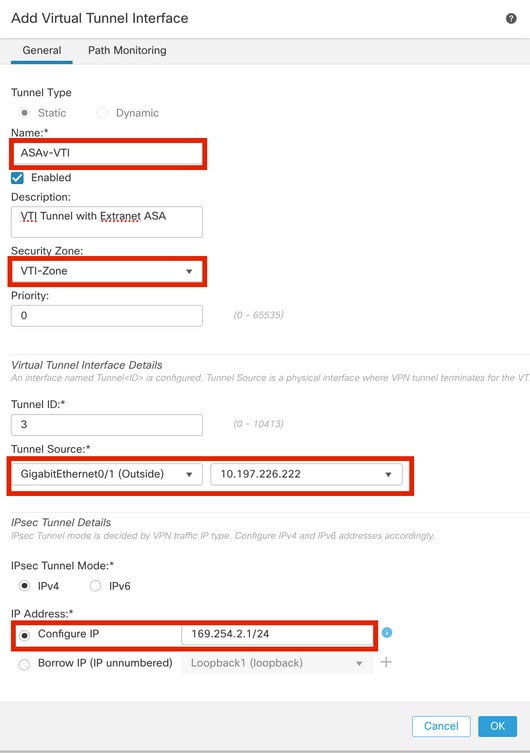 Interfaccia tunnel virtuale
Interfaccia tunnel virtuale
Passaggio 6. FareOK clic sul menu a comparsa per indicare che la nuova VTI è stata creata.
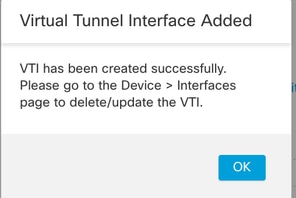 Aggiunta interfaccia tunnel virtuale
Aggiunta interfaccia tunnel virtuale
Passaggio 7. Scegliere la VTI appena creata o una VTI in Virtual Tunnel Interface. Fornire le informazioni per il nodo B (che è il dispositivo peer).
Per questa dimostrazione:
Dispositivo: Extranet
Nome dispositivo: ASAv-Peer
Indirizzo IP endpoint: 10.197.226.187
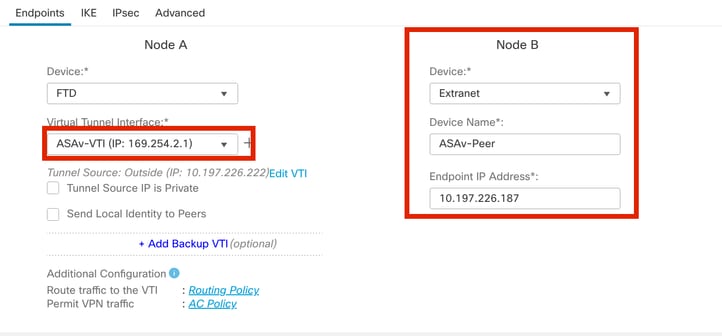 Nodo endpoint B
Nodo endpoint B
Passaggio 8. Passare alla scheda IKE. Fare clic su  . È possibile scegliere di utilizzare un predefinito
. È possibile scegliere di utilizzare un predefinito Policy o fare clic sul +pulsante accanto alla Policyscheda per crearne uno nuovo.
Passaggio 9. (Facoltativo, se si crea un nuovo criterio IKEv2.) Fornire un Namenome per il criterio e selezionare quello Algorithms da utilizzare nel criterio. Fare clic su .Save
Per questa dimostrazione:
Nome: ASAv-IKEv2-policy
Algoritmi di integrità: SHA-256
Algoritmi di crittografia: AES-256
Algoritmi PRF: SHA-256
Gruppo Diffie-Hellman: 14
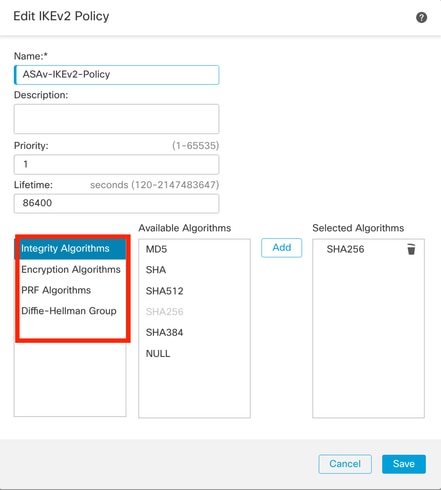 Criterio IKEv2
Criterio IKEv2
Passaggio 10. Scegliere il file appena creato Policy o Policyquello esistente. Selezionare la Authentication Typevoce. Key Se si utilizza una chiave manuale già condivisa, immettere la chiave nella Confirm Key casella e.
Per questa dimostrazione:
Criterio: ASAv-IKEv2-Policy
Tipo di autenticazione: chiave manuale già condivisa
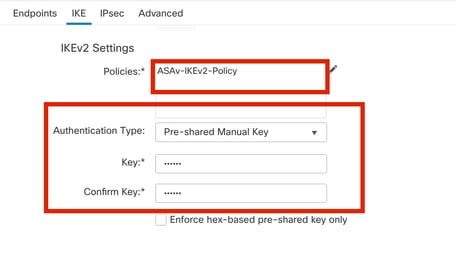 Autenticazione
Autenticazione
Passaggio 11. Passare alla IPsec scheda. Fare clic su  Può scegliere se utilizzare una proposta IPSec IKEv2 predefinita o crearne una nuova. Fare clic sul
Può scegliere se utilizzare una proposta IPSec IKEv2 predefinita o crearne una nuova. Fare clic sul +pulsante accanto alla IKEv2 IPsec Proposal scheda.
Passaggio 12. (Facoltativo, se si crea una nuova proposta IPSec IKEv2.) Immettere un valore Nameper la proposta e selezionare quelloAlgorithms da utilizzare nella proposta. Fare clic su .Save
Per questa dimostrazione:
Nome: ASAv-IPSec-Policy
Hash ESP: SHA-256
Crittografia ESP: AES-256
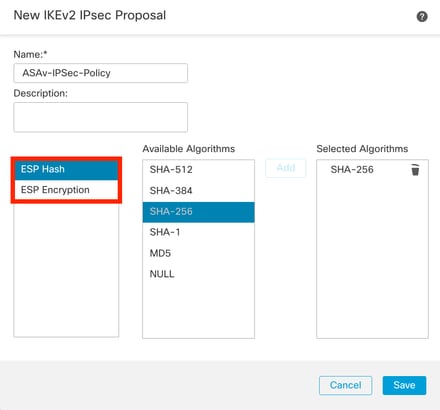 Proposta IKEv2-IPsec
Proposta IKEv2-IPsec
Passaggio 13. Scegliere la nuova proposta creata Proposal o Proposalquella esistente dall'elenco delle proposte disponibili. Fare clic su .OK
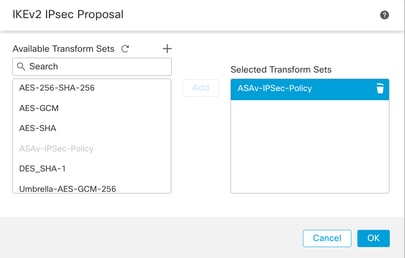 Set di trasformazioni
Set di trasformazioni
Passaggio 14. (Facoltativo) Scegliere le Perfect Forward Secrecy impostazioni. Configurare IPSecLifetime Duration and Lifetime Size.
Per questa dimostrazione:
Perfect Forward Secrecy: Gruppo di moduli 14
Durata: 28800 (predefinita)
Dimensione durata: 4608000 (predefinita)
 Configurazione PFS
Configurazione PFS
Passaggio 15. Controllare le impostazioni configurate. Fare clic suSave, come mostrato nell'immagine.
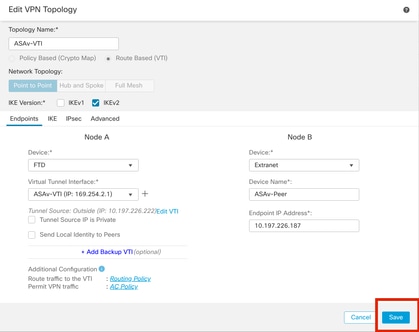 Salvataggio della configurazione
Salvataggio della configurazione
Configurazione dell'interfaccia di loopback su FTD mediante FMC
Configurazione dell'interfaccia di loopback su FTD mediante FMC
Passare a Devices > Device Management . Modificare il dispositivo in cui è necessario configurare il loopback.
Passaggio 1. Andare su Interfaces > Add Interfaces > Loopback Interface .
 Passa all'interfaccia di loopback
Passa all'interfaccia di loopback
Passaggio 2. Immettere il nome "loopback", fornire un ID loopback "1" e abilitare l'interfaccia.
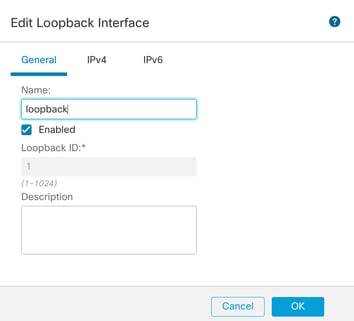 Abilitazione dell'interfaccia di loopback
Abilitazione dell'interfaccia di loopback
Passaggio 3. Configurare l'indirizzo IP per l'interfaccia, quindi fare clic su OK .
 Specificare l'indirizzo IP per l'interfaccia di loopback
Specificare l'indirizzo IP per l'interfaccia di loopback
Configurazione della VPN IPSec sull'appliance ASA
Configurazione della VPN IPSec sull'appliance ASA
!--- Configure IKEv2 Policy ---!
crypto ikev2 policy 1
encryption aes-256
integrity sha256
group 14
prf sha256
lifetime seconds 86400
!--- Enable IKEv2 on the outside interface ---!
crypto ikev2 enable outside
!---Configure Tunnel-Group with pre-shared-key---!
tunnel-group 10.197.226.222 type ipsec-l2l
tunnel-group 10.197.226.222 ipsec-attributes
ikev2 remote-authentication pre-shared-key *****
ikev2 local-authentication pre-shared-key *****
!--- Configure IPSec Policy ---!
crypto ipsec ikev2 ipsec-proposal ipsec_proposal_for_FTD
protocol esp encryption aes-256
protocol esp integrity sha-256
!--- Configure IPSec Profile ---!
crypto ipsec profile ipsec_profile_for_FTD
set ikev2 ipsec-proposal FTD-ipsec-proposal
set pfs group14
!--- Configure VTI ---!
interface Tunnel1
nameif FTD-VTI
ip address 169.254.2.2 255.255.255.0
tunnel source interface outside
tunnel destination 10.197.226.222
tunnel mode ipsec ipv4
tunnel protection ipsec profile ipsec_profile_for_FTD
!--- Configure the WAN routes ---!
route outside 0.0.0.0 0.0.0.0 10.197.226.1 1
Configurazione dell'interfaccia di loopback sull'appliance ASA
interface Loopback1
nameif loopback
ip address 1.1.1.1 255.255.255.0
Configurare l'overlay di BGP su FTD tramite FMC
Passare a Devices > Device Management.Edit il dispositivo su cui è configurato il tunnel VTI, quindi passare a Routing >General Settings > BGP.
Passaggio 1. Abilitare BGP e configurare il numero AS (Autonomous System) e l'ID del router, come mostrato in questa immagine.
Il numero AS deve essere lo stesso su entrambi i dispositivi FTD e ASA.
L'ID del router viene usato per identificare ciascun router che partecipa al BGP.
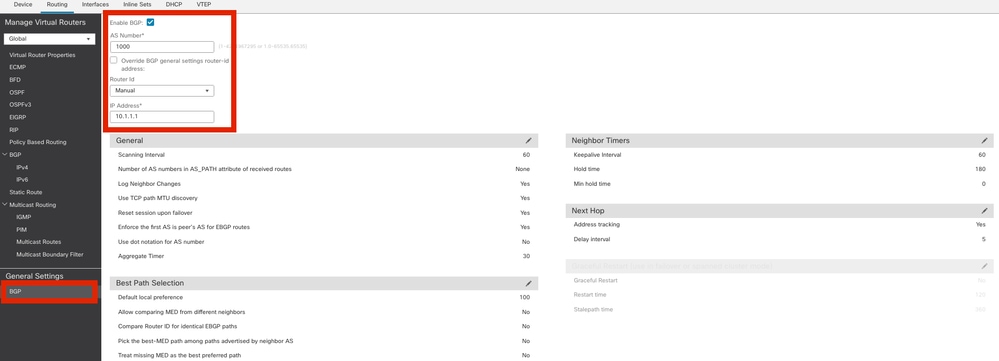 Passare alla configurazione di BGP
Passare alla configurazione di BGP
Passaggio 2. PassareBGP > IPv4 a BGP IPv4 su FTD e abilitarlo.
 Abilita BGP
Abilita BGP
Passaggio 3. NellaNeighbor scheda, aggiungere l'indirizzo IP del tunnel VTI ASAv come router adiacente e abilitare il router adiacente.
 Aggiungi BGP adiacente
Aggiungi BGP adiacente
Passaggio 4. In Networks aggiungere le reti che si desidera annunciare tramite BGP che devono passare attraverso il tunnel VTI, in questo caso loopback1.
 Aggiungi reti BGP
Aggiungi reti BGP
Passaggio 5. Tutte le altre impostazioni BGP sono facoltative ed è possibile configurarle in base all'ambiente. Verificare la configurazione e fare clic su Save.
 Salva configurazione BGP
Salva configurazione BGP
Passaggio 6. distribuire tutte le configurazioni.
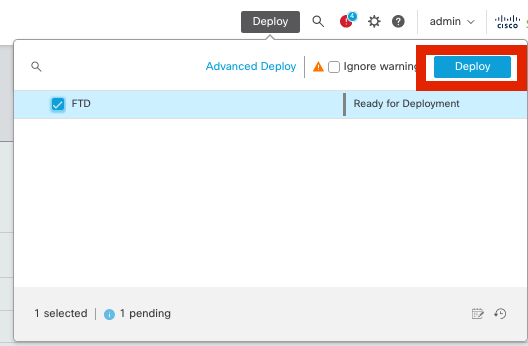 Implementazione
Implementazione
Configurazione dell'overlay di BGP sull'appliance ASA
router bgp 1000
bgp log-neighbor-changes
bgp router-id 10.1.1.2
address-family ipv4 unicast
neighbor 169.254.2.1 remote-as 1000
neighbor 169.254.2.1 transport path-mtu-discovery disable
neighbor 169.254.2.1 activate
network 1.1.1.0 mask 255.255.255.0
no auto-summary
no synchronization
exit-address-family
Verifica
Fare riferimento a questa sezione per verificare che la configurazione funzioni correttamente.
Output su FTD
#show crypto ikev2 sa
IKEv2 SAs:
Session-id:20, Status:UP-ACTIVE, IKE count:1, CHILD count:1
Tunnel-id Local Remote fvrf/ivrf Status Role
666846307 10.197.226.222/500 10.197.226.187/500 Global/Global READY RESPONDER
Encr: AES-CBC, keysize: 256, Hash: SHA256, DH Grp:14, Auth sign: PSK, Auth verify: PSK
Life/Active Time: 86400/1201 sec
Child sa: local selector 0.0.0.0/0 - 255.255.255.255/65535
remote selector 0.0.0.0/0 - 255.255.255.255/65535
ESP spi in/out: 0xa14edaf6/0x8540d49e
#show crypto ipsec sa
interface: ASAv-VTI
Crypto map tag: __vti-crypto-map-Tunnel1-0-1, seq num: 65280, local addr: 10.197.226.222
Protected vrf (ivrf): Global
local ident (addr/mask/prot/port): (0.0.0.0/0.0.0.0/0/0)
remote ident (addr/mask/prot/port): (0.0.0.0/0.0.0.0/0/0)
current_peer: 10.197.226.187
#pkts encaps: 45, #pkts encrypt: 45, #pkts digest: 45
#pkts decaps: 44, #pkts decrypt: 44, #pkts verify: 44
#pkts compressed: 0, #pkts decompressed: 0
#pkts not compressed:0, #pkts comp failed: 0, #pkts decomp failed: 0
#pre-frag successes: 0, #pre-frag failures: 0, #fragments created: 0
#PMTUs sent: 0, #PMTUs rcvd: 0, #decapsulated frgs needing reassembly: 0
#TFC rcvd: 0, #TFC sent: 0
#Valid ICMP Errors rcvd: 0, #Invalid ICMP Errors rcvd: 0
#send errors: 0, #recv errors: 0
local crypto endpt.: 10.197.226.222/500, remote crypto endpt.: 10.197.226.187/500
path mtu 1500, ipsec overhead 78(44), media mtu 1500
PMTU time remaining (sec): 0, DF policy: copy-df
ICMP error validation: disabled, TFC packets: disabled
current outbound spi: 8540D49E
current inbound spi : A14EDAF6
inbound esp sas:
spi: 0xA14EDAF6 (2706299638)
SA State: active
transform: esp-aes-256 esp-sha-256-hmac no compression
in use settings ={L2L, Tunnel, PFS Group 14, IKEv2, VTI, }
slot: 0, conn_id: 49, crypto-map: __vti-crypto-map-Tunnel1-0-1
sa timing: remaining key lifetime (kB/sec): (4331517/27595)
IV size: 16 bytes
replay detection support: Y
Anti replay bitmap:
000001FFF 0xFFFFFFFF
outbound esp sas:
spi: 0x8540D49E (2235618462)
SA State: active
transform: esp-aes-256 esp-sha-256-hmac no compression
in use settings ={L2L, Tunnel, PFS Group 14, IKEv2, VTI, }
slot: 0, conn_id: 49, crypto-map: __vti-crypto-map-Tunnel1-0-1
sa timing: remaining key lifetime (kB/sec): (4101117/27595)
IV size: 16 bytes
replay detection support: Y
Anti replay bitmap:
0x00000000 0x00000001
#show bgp summary
BGP router identifier 10.1.1.1, local AS number 1000
BGP table version is 5, main routing table version 5
2 network entries using 400 bytes of memory
2 path entries using 160 bytes of memory
2/2 BGP path/bestpath attribute entries using 416 bytes of memory
0 BGP route-map cache entries using 0 bytes of memory
0 BGP filter-list cache entries using 0 bytes of memory
BGP using 976 total bytes of memory
BGP activity 21/19 prefixes, 24/22 paths, scan interval 60 secs
Neighbor V AS MsgRcvd MsgSent TblVer InQ OutQ Up/Down State/PfxRcd
169.254.2.2 4 1000 22 22 5 0 0 00:19:42 1
#show bgp neighbors
BGP neighbor is 169.254.2.2, vrf single_vf, remote AS 1000, internal link
BGP version 4, remote router ID 10.1.1.2
BGP state = Established, up for 00:19:49
Last read 00:01:04, last write 00:00:38, hold time is 180, keepalive interval is 60 seconds
Neighbor sessions:
1 active, is not multisession capable (disabled)
Neighbor capabilities:
Route refresh: advertised and received(new)
Four-octets ASN Capability: advertised and received
Address family IPv4 Unicast: advertised and received
Multisession Capability:
Message statistics:
InQ depth is 0
OutQ depth is 0
Sent Rcvd
Opens 1 1
Notifications: 0 0
Updates: 2 2
Keepalives: 19 19
Route Refresh: 0 0
Total: 22 22
Default minimum time between advertisement runs is 0 seconds
For address family: IPv4 Unicast
Session: 169.254.2.2
BGP table version 5, neighbor version 5/0
Output queue size : 0
Index 15
15 update-group member
Sent Rcvd
Prefix activity: ---- ----
Prefixes Current: 1 1 (Consumes 80 bytes)
Prefixes Total: 1 1
Implicit Withdraw: 0 0
Explicit Withdraw: 0 0
Used as bestpath: n/a 1
Used as multipath: n/a 0
Outbound Inbound
Local Policy Denied Prefixes: -------- -------
Bestpath from this peer: 1 n/a
Invalid Path: 1 n/a
Total: 2 0
Number of NLRIs in the update sent: max 1, min 0
Address tracking is enabled, the RIB does have a route to 169.254.2.2
Connections established 7; dropped 6
Last reset 00:20:06, due to Peer closed the session of session 1
Transport(tcp) path-mtu-discovery is disabled
Graceful-Restart is disabled
#show route bgp
Codes: L - local, C - connected, S - static, R - RIP, M - mobile, B - BGP
D - EIGRP, EX - EIGRP external, O - OSPF, IA - OSPF inter area
N1 - OSPF NSSA external type 1, N2 - OSPF NSSA external type 2
E1 - OSPF external type 1, E2 - OSPF external type 2, V - VPN
i - IS-IS, su - IS-IS summary, L1 - IS-IS level-1, L2 - IS-IS level-2
ia - IS-IS inter area, * - candidate default, U - per-user static route
o - ODR, P - periodic downloaded static route, + - replicated route
SI - Static InterVRF, BI - BGP InterVRF
Gateway of last resort is 10.197.226.1 to network 0.0.0.0
B 1.1.1.0 255.255.255.0 [200/0] via 169.254.2.2, 00:19:55
Output sull'appliance ASA
#show crypto ikev2 sa
IKEv2 SAs:
Session-id:7, Status:UP-ACTIVE, IKE count:1, CHILD count:1
Tunnel-id Local Remote fvrf/ivrf Status Role
442126361 10.197.226.187/500 10.197.226.222/500 Global/Global READY INITIATOR
Encr: AES-CBC, keysize: 256, Hash: SHA256, DH Grp:14, Auth sign: PSK, Auth verify: PSK
Life/Active Time: 86400/1200 sec
Child sa: local selector 0.0.0.0/0 - 255.255.255.255/65535
remote selector 0.0.0.0/0 - 255.255.255.255/65535
ESP spi in/out: 0x8540d49e/0xa14edaf6
#show crypto ipsec sa
interface: FTD-VTI
Crypto map tag: __vti-crypto-map-Tunnel1-0-1, seq num: 65280, local addr: 10.197.226.187
Protected vrf (ivrf): Global
local ident (addr/mask/prot/port): (0.0.0.0/0.0.0.0/0/0)
remote ident (addr/mask/prot/port): (0.0.0.0/0.0.0.0/0/0)
current_peer: 10.197.226.222
#pkts encaps: 44 #pkts encrypt: 44, #pkts digest: 44
#pkts decaps: 45, #pkts decrypt: 45, #pkts verify: 45
#pkts compressed: 0, #pkts decompressed: 0
#pkts not compressed:0, #pkts comp failed: 0, #pkts decomp failed: 0
#pre-frag successes: 0, #pre-frag failures: 0, #fragments created: 0
#PMTUs sent: 0, #PMTUs rcvd: 0, #decapsulated frgs needing reassembly: 0
#TFC rcvd: 0, #TFC sent: 0
#Valid ICMP Errors rcvd: 0, #Invalid ICMP Errors rcvd: 0
#send errors: 0, #recv errors: 0
local crypto endpt.: 10.197.226.187/500, remote crypto endpt.: 10.197.226.222/500
path mtu 1500, ipsec overhead 78(44), media mtu 1500
PMTU time remaining (sec): 0, DF policy: copy-df
ICMP error validation: disabled, TFC packets: disabled
current outbound spi: A14EDAF6
current inbound spi : 8540D49E
inbound esp sas:
spi: 0x8540D49E (2235618462)
SA State: active
transform: esp-aes-256 esp-sha-256-hmac no compression
in use settings ={L2L, Tunnel, PFS Group 14, IKEv2, VTI, }
slot: 0, conn_id: 9, crypto-map: __vti-crypto-map-Tunnel1-0-1
sa timing: remaining key lifetime (kB/sec): (4147198/27594)
IV size: 16 bytes
replay detection support: Y
Anti replay bitmap:
0x00000000 0x007FFFFF
outbound esp sas:
spi: 0xA14EDAF6 (2706299638)
SA State: active
transform: esp-aes-256 esp-sha-256-hmac no compression
in use settings ={L2L, Tunnel, PFS Group 14, IKEv2, VTI, }
slot: 0, conn_id: 9, crypto-map: __vti-crypto-map-Tunnel1-0-1
sa timing: remaining key lifetime (kB/sec): (3916798/27594)
IV size: 16 bytes
replay detection support: Y
Anti replay bitmap:
0x00000000 0x00000001
#show bgp summary
BGP router identifier 10.1.1.2, local AS number 1000
BGP table version is 7, main routing table version 7
2 network entries using 400 bytes of memory
2 path entries using 160 bytes of memory
2/2 BGP path/bestpath attribute entries using 416 bytes of memory
0 BGP route-map cache entries using 0 bytes of memory
0 BGP filter-list cache entries using 0 bytes of memory
BGP using 976 total bytes of memory
BGP activity 5/3 prefixes, 7/5 paths, scan interval 60 secs
Neighbor V AS MsgRcvd MsgSent TblVer InQ OutQ Up/Down State/PfxRcd
169.254.2.1 4 1000 22 22 7 0 0 00:19:42 1
#show bgp neighbors
BGP neighbor is 169.254.2.1, context single_vf, remote AS 1000, internal link
BGP version 4, remote router ID 10.1.1.1
BGP state = Established, up for 00:19:42
Last read 00:01:04, last write 00:00:38, hold time is 180, keepalive interval is 60 seconds
Neighbor sessions:
1 active, is not multisession capable (disabled)
Neighbor capabilities:
Route refresh: advertised and received(new)
Four-octets ASN Capability: advertised and received
Address family IPv4 Unicast: advertised and received
Multisession Capability:
Message statistics:
InQ depth is 0
OutQ depth is 0
Sent Rcvd
Opens: 1 1
Notifications: 0 0
Updates: 2 2
Keepalives: 19 19
Route Refresh: 0 0
Total: 22 22
Default minimum time between advertisement runs is 0 seconds
For address family: IPv4 Unicast
Session: 169.254.2.1
BGP table version 7, neighbor version 7/0
Output queue size : 0
Index 5
5 update-group member
Sent Rcvd
Prefix activity: ---- ----
Prefixes Current: 1 1 (Consumes 80 bytes)
Prefixes Total: 1 1
Implicit Withdraw: 0 0
Explicit Withdraw: 0 0
Used as bestpath: n/a 1
Used as multipath: n/a 0
Outbound Inbound
Local Policy Denied Prefixes: -------- -------
Bestpath from this peer: 1 n/a
Invalid Path: 1 n/a
Total: 2 0
Number of NLRIs in the update sent: max 1, min 0
Address tracking is enabled, the RIB does have a route to 169.254.2.1
Connections established 5; dropped 4
Last reset 00:20:06, due to Peer closed the session of session 1
Transport(tcp) path-mtu-discovery is disabled
Graceful-Restart is disabled
#show route bgp
Codes: L - local, C - connected, S - static, R - RIP, M - mobile, B - BGP
D - EIGRP, EX - EIGRP external, O - OSPF, IA - OSPF inter area
N1 - OSPF NSSA external type 1, N2 - OSPF NSSA external type 2
E1 - OSPF external type 1, E2 - OSPF external type 2, V - VPN
i - IS-IS, su - IS-IS summary, L1 - IS-IS level-1, L2 - IS-IS level-2
ia - IS-IS inter area, * - candidate default, U - per-user static route
o - ODR, P - periodic downloaded static route, + - replicated route
SI - Static InterVRF, BI - BGP InterVRF
Gateway of last resort is 10.197.226.1 to network 0.0.0.0
B 2.2.2.0 255.255.255.0 [200/0] via 169.254.2.1, 00:19:55
Risoluzione dei problemi
Le informazioni contenute in questa sezione permettono di risolvere i problemi relativi alla configurazione.
debug crypto ikev2 platform 255
debug crypto ikev2 protocol 255
debug crypto ipsec 255
debug ip bgp all
- Supporta solo interfacce IPv4, IPv4, reti protette o payload VPN (nessun supporto per IPv6).
Cronologia delle revisioni
| Revisione | Data di pubblicazione | Commenti |
|---|---|---|
1.0 |
13-Jun-2024 |
Versione iniziale |
Contributo dei tecnici Cisco
- Amrutha MCisco TAC Engineer
 Feedback
Feedback